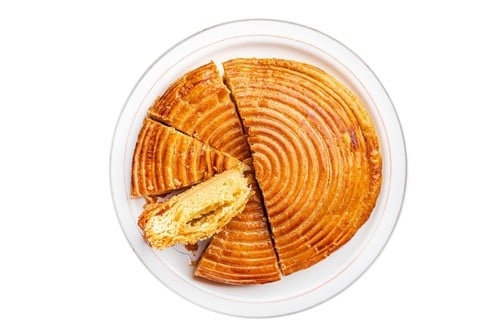Those of you who have had the pleasure of visiting France in January have likely come across the galette des rois at a French bakery. Translating literally to “king’s cake,” it’s a specialty typically eaten on the Christian holiday of the Epiphany which occurs annually on January 6.
The Epiphany is also known as Twelfth Night or Three Kings’ Day, and it commemorates the visit of the Magi to the baby Jesus. Knowing this, it makes sense that they call the cake a galette des rois.
Most bakeries sell the cake throughout the month of January, and in true French baked goods’ fashion, these days there are several different flavors to choose from. That’s not all that makes this dessert special — let’s explore some other noteworthy facts about the incredibly tasty (in my humble opinion as a French pastry chef’s wife) galette des rois.
The History
The origins of the galette des rois can be traced back to the ancient Roman festival of Saturnalia, which was a time pour faire la fête during the winter solstice. Over the years, the tradition transformed — as Christianity spread across Europe, many pagan festivals were adapted and incorporated into Christian celebrations, and by the Middle Ages, the king’s cake became synonymous with the Feast of the Epiphany.
While the specific foods served at Saturnalia may not have included a cake exactly like the galette des rois, the festive atmosphere and the idea of indulging in special foods during this period laid the groundwork for later customs.
In France, the tradition of baking a special cake for the Epiphany gained popularity during the 14th century. Initially, a single bean was hidden in the cake to represent the Christ child. The person who discovered the bean in their slice was crowned the “king” or “queen” for the day. As the tradition evolved, porcelain figurines, known as fèves, or “favors,” gradually replaced beans. Today, these they come in various themes, ranging from religious symbols to whimsical characters.
Most of the French people I know collect them — although just the other day, after finding a jar full of them in the cupboard, my father-in-law shook his head and said, pourquoi on garde ces trucs? (why do we keep these things?). Perhaps because they’re too cute to throw away?
The Hidden Fève Tradition
The practice of hiding a favor inside the galette des rois does have a fascinating history. Originally, the fève was a simple bean that symbolized fertility and prosperity. With the advent of the 16th century, porcelain emerged as the material of choice. The themes of the fèves soon grew beyond religious symbols to encompass a wide array of subjects, from mini moons and stars to small cats, dogs, and other animals.
I first discovered the pure joy of discovering the fève when I was an au pair. I sat around the table with my host family, and the dad began to slice the cake into equal parts. Then, the youngest in the family was tasked with deciding the order in which the slices were served. She quickly ran to hide under the table (as is tradition to avoid any cheating), made her choices, and we all dug in. The middle child shouted when he found the favor — he was officially king for the day.
Galette des Rois Today
Like many traditional pastries, the galette des rois has transcended its roots and modern bakeries now put their own unique twist on the almond-filled cake. While the classic version, made with pâte feuilletée, frangipane, and sweet almond cream, still reigns, many pastry chefs now create some truly unique versions.
My favorites? Pistachio from Babka Zana in the 9th and Ladurée’s version that reminds me of American pecan pie. This year I also can’t wait to try the French Bastard’s hommage to the pain au chocolat — the modern pastry shop’s galette looks like it’s covered in chocolate-filled croissants — it promises to be a délice. Bakeries tend to engage in friendly competition, each vying to produce the most unique and delectable version.
Flavors aside, the presentation of the king’s cake has also undergone a transformation. Artistic designs, intricate shapes, and even savory renditions have found a place. The galette de rois serves not only as a symbol of celebration but also as a testament to the ever-evolving world of French cuisine…and pastries, of course (hey, I told you I was a pastry chef’s wife).
Did you enjoy this article? TAIP is 100% reader-supported through tipping. If you want to leave us a tip of any amount it would be highly appreciated. These tips help support our efforts to keep TAIP an ad-free environment. Just like at a cafe, the tips are split evenly among the team.

